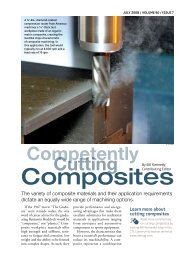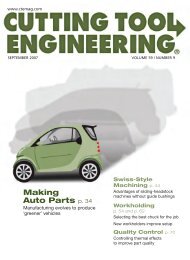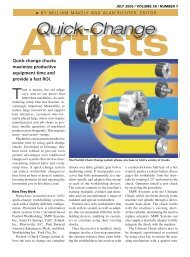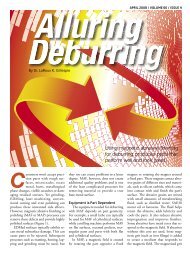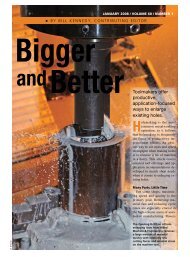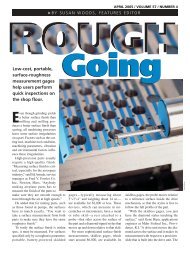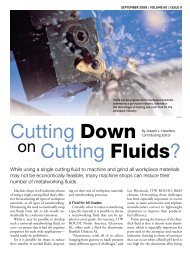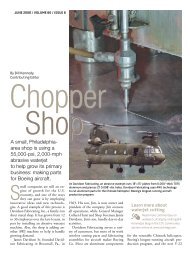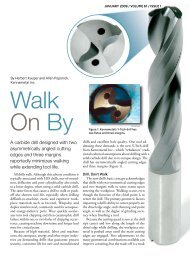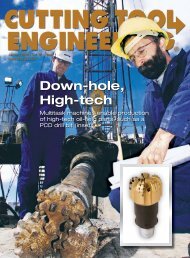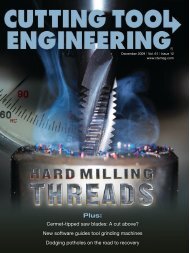Tool coatings harder than AlTiN coatings are applied via a process ...
Tool coatings harder than AlTiN coatings are applied via a process ...
Tool coatings harder than AlTiN coatings are applied via a process ...
You also want an ePaper? Increase the reach of your titles
YUMPU automatically turns print PDFs into web optimized ePapers that Google loves.
Harder<br />
APRIL 2008 / VOLUME 60 / ISSUE 4<br />
By Joseph L. Hazelton, Senior Editor<br />
with Silicon<br />
<strong>Tool</strong> <strong>coatings</strong> <strong>harder</strong> <strong>than</strong> <strong>AlTiN</strong> <strong>coatings</strong> <strong>are</strong> <strong>applied</strong><br />
<strong>via</strong> a <strong>process</strong> that combines <strong>AlTiN</strong> particles with an<br />
amorphous silicon nitride (Si 3<br />
N 4<br />
) matrix.<br />
Seeing is believing, but it may require<br />
testing first. That was the case for<br />
toolmaker Melin <strong>Tool</strong> Co., Cleveland,<br />
when it was presented a coating<br />
called nACo, which the coating company<br />
said was <strong>harder</strong>, more wear resistant and had<br />
a higher hot hardness <strong>than</strong> <strong>AlTiN</strong>.<br />
Melin <strong>Tool</strong> performed in-house tests on<br />
nACo, which refers to nanocomposite, applying<br />
the coating to a series CCMG 45 6-<br />
flute endmill for cutting hardened steel and<br />
comparing its tool life to the same-style endmill<br />
coated with <strong>AlTiN</strong>. “We found about<br />
a 27 percent increase in tool life with the<br />
nACo coating,” said Mike Wochna, Melin<br />
<strong>Tool</strong>’s president.<br />
Also, the nACo-coated tool had a hardness<br />
of 45 GPa vs. 38 GPa for the <strong>AlTiN</strong>-coated<br />
tool. “It creates a <strong>harder</strong> surface,” Wochna<br />
said of nACo.<br />
Besides endmills, Melin <strong>Tool</strong> offers the<br />
nACo coating on its high-performance,<br />
through-coolant drills and ballnose endmills<br />
for making dies and molds. All three types<br />
of tools <strong>are</strong> made from 91 HRC solid carbide<br />
and <strong>are</strong> for cutting workpiece materials<br />
of about 45 HRC to 65 HRC. In all cases,<br />
the tools <strong>are</strong> usually for cutting hardened<br />
steel, cast iron, high-silicon aluminum and<br />
superalloys.<br />
Moreover, nACo has a high hot hardness.<br />
As a nanocomposite coating, it can withstand<br />
heat up to 1,200° C before it starts to<br />
oxidize and break down.<br />
Filling the Spaces<br />
nACo’s hardness results from its nanocomposite<br />
structure. The coating consists<br />
of nanocrystalline <strong>AlTiN</strong> grains embedded<br />
in an amorphous Si 3<br />
N 4<br />
matrix. According<br />
to the coating and coating equipment<br />
company, Platit AG, Grenchen, Switzerland,<br />
this structure increases hardness partly because<br />
the matrix acts as a diffusion barrier,<br />
preventing the grains from growing. “The<br />
smaller the grains, the higher the hardness,”<br />
said Bo Torp, sales manager of Platit Inc.,<br />
Libertyville, Ill.<br />
The matrix also contributes to the coating’s<br />
hardness. Torp comp<strong>are</strong>d the grains and<br />
matrix to wet sand. On a beach, a person’s<br />
feet usually sink into dry sand, but they<br />
won’t sink, or won’t sink as far, in wet sand.<br />
The reason is the space between the grains<br />
Nanocomposite nACo coating on tungsten-carbide tools:<br />
suitable <strong>process</strong>es and workpiece materials.<br />
Drilling Milling Reaming Tapping<br />
Steels X X<br />
Hardened steels X X X<br />
Cast iron X X X X<br />
Aluminum<br />
(> 12 percent Si)<br />
X X X<br />
Superalloys X X X<br />
Source: Platit<br />
Melin <strong>Tool</strong>
is occupied by water, not air. Consequently,<br />
wet sand has a higher resistance,<br />
is <strong>harder</strong>. Likewise, the matrix<br />
occupies the space between the grains<br />
and makes the coating <strong>harder</strong>.<br />
nACo’s nanocomposite structure can<br />
increase a machine shop’s productivity<br />
and reduce its costs. “You can improve<br />
feeds and speeds, or you can start running<br />
dry,” Torp said.<br />
Melin <strong>Tool</strong> applies the coating inhouse<br />
with a Platit π 80 coating machine.<br />
Torp estimated that the coating<br />
is appropriate for 90 percent of carbide<br />
tools. He added that it’s mainly unsuitable<br />
for HSS tools because the substrate<br />
usually isn’t hard enough to sustain the<br />
coating. nACo, however, can be <strong>applied</strong><br />
to other styles of cutting tools and can<br />
be used when cutting different workpiece<br />
materials (Table).<br />
Standard Coatings Too<br />
The π 80 can apply TiN, TiCN,<br />
TiAlN and <strong>AlTiN</strong> and other <strong>coatings</strong>,<br />
too. Also, it can apply some of<br />
those <strong>coatings</strong> with monolayer, multilayer,<br />
nanogradient, nanolayer and<br />
Inside the machine<br />
The π 80 machine can create<br />
nanocomposite nACo and other <strong>coatings</strong><br />
<strong>via</strong> its LARC (lateral rotating ARCcathodes)<br />
technology.<br />
Platit states that LARC technology can<br />
use plasma-generating physical vapor<br />
deposition to apply <strong>coatings</strong> to tungstencarbide<br />
cutting tools with greater<br />
hardness, wear resistance and heat<br />
resistance <strong>than</strong> other <strong>AlTiN</strong> <strong>coatings</strong>.<br />
A LARC-equipped machine features<br />
two rotating, cylindrical, water-cooled<br />
cathodes that <strong>are</strong> laterally about 200mm<br />
from center to center. Inside the cathodes<br />
<strong>are</strong> coils and permanent magnets<br />
for generating a magnetic field. Each<br />
cathode’s magnetic equipment can rotate<br />
independent of the cathode itself.<br />
Before coating, the cathodes and<br />
magnetic equipment <strong>are</strong> rotated and<br />
turned on so the cathodes apply their<br />
initial <strong>AlTiN</strong> droplets, usually large<br />
particles, against one of the machine’s<br />
interior walls. At the same time, the<br />
workpieces can be cleaned <strong>via</strong> the<br />
machine’s plasma.<br />
After the droplets become smaller, the<br />
cathodes and magnetic equipment <strong>are</strong><br />
rotated again so the cathodes apply the<br />
AlTiSiN particles to the tools’ now-clean<br />
surfaces. Simultaneously, the magnetic<br />
field controls the deposition rate, with the<br />
<strong>AlTiN</strong> and Si 3<br />
N 4<br />
segregating at the tool<br />
surface.<br />
Also, the cathodes’ and magnetic<br />
equipment’s movements allow the LARC<br />
machine to create a coating with a surface<br />
roughness of 0.07µm R a<br />
to 0.15µm R a<br />
.<br />
Besides creating a nanocomposite<br />
structure, a LARC machine can contribute<br />
to the nACo coating’s hardness through<br />
its ability to be programmed to create<br />
continuously changing nanogradients.<br />
For example, when first coating a batch<br />
of tools, the machine will apply titanium<br />
nitride first for maximum adhesion and<br />
then aluminum titanium nitride. As<br />
coating progresses, the aluminum content<br />
is continuously increased, which increases<br />
the coating’s hardness, temperature<br />
stability and oxidation resistance.<br />
—J.L. Hazelton
Harder with Silicon (continued)<br />
nanocomposite structures, and in their<br />
combined structures. The machine can<br />
coat tool steels at higher <strong>than</strong> 230° C,<br />
HSS at 350° to 500° C and tungsten<br />
carbide at 350° to 600° C.<br />
Melin <strong>Tool</strong> itself used its π 80 strictly<br />
for applying the more traditional <strong>coatings</strong><br />
during its first 10 months of owning<br />
the machine, until this past September.<br />
The toolmaker knew it would<br />
eventually use the machine<br />
to apply the nACo coating,<br />
but it wanted to first learn<br />
to use the π 80 for more traditional<br />
<strong>coatings</strong>.<br />
Wochna purchased the<br />
π 80 after researching coating<br />
machines <strong>via</strong> printed<br />
literature, the Internet and<br />
conversations with coating<br />
equipment companies and<br />
other toolmakers. Wochna<br />
had narrowed the choice<br />
to two machines from<br />
two companies when he<br />
attended IMTS in September<br />
2006, where both<br />
companies were exhibiting.<br />
After comparing the companies’<br />
displayed models,<br />
Wochna chose the π 80 for<br />
several reasons, including<br />
its ease of use, flexibility and setup and<br />
changeover times.<br />
Two months later, Platit installed the<br />
coating machine at Melin <strong>Tool</strong>’s factory.<br />
By then, the toolmaker was ready with<br />
suitable fixturing and a separate clean<br />
room for the π 80 on the shop floor so it<br />
could put the machine into production<br />
use quickly. After installation, Melin<br />
<strong>Tool</strong> technicians were trained on the π 80<br />
within a week.<br />
“We have found it to be very flexible,”<br />
Wochna said. He described<br />
the π 80 ’s changeover time as short,<br />
contributors<br />
Melin <strong>Tool</strong> Co.<br />
(800) 521-1078<br />
www.melintool.com<br />
Platit Inc.<br />
(847) 680-5270<br />
www.platit.com<br />
saying that the machine can switch<br />
between applying three different <strong>coatings</strong><br />
to three different batches of tools<br />
in a 10-hour period. “We usually<br />
run three batches per day in one 9-<br />
hour shift,” Wochna said. “The last<br />
batch goes in at end of shift and runs<br />
lights out.”<br />
Limited Use, A Solution?<br />
However, the nACo coating has a<br />
Hardness Increase through Nanocomposites<br />
Hardness<br />
Structure<br />
TiAIN<br />
TiAIN+<br />
Si 3<br />
N 4<br />
Si 3<br />
N 4<br />
<strong>AlTiN</strong><br />
Like water between sand grains, an amorphous Si 3<br />
N 4<br />
matrix fills the spaces between <strong>AlTiN</strong> grains, making the<br />
coating less compressible and therefore <strong>harder</strong>.<br />
Platit<br />
limitation. “It is a brittle coating by<br />
nature,” Wochna said. “That’s probably<br />
the biggest limiting factor.”<br />
Its brittleness means the coating can<br />
crack and flake off a tool’s cutting edge.<br />
A rigid setup, such as used in highperformance<br />
drilling and milling, reduces<br />
vibration that can cause a cutting<br />
edge to chatter and thereby reduces the<br />
chance of cracking and flaking.<br />
Melin <strong>Tool</strong>’s goal is to extend the<br />
range of application so nACo can be a<br />
more universal coating, like <strong>AlTiN</strong> is.<br />
Specifically, Melin <strong>Tool</strong> is experimenting<br />
with application of a thin layer of<br />
<strong>AlTiN</strong> under a multilayer nACo coating<br />
to protect a tool’s cutting edge. That<br />
way, if the nACo coating cracks and<br />
flakes off, the cutting edge will still have<br />
a protective coating.<br />
For this multilayer strategy, Melin<br />
<strong>Tool</strong> will need a second π 80 or a larger<br />
Platit machine to apply the <strong>AlTiN</strong> and<br />
nACo layers. With two π 80 machines,
Platit<br />
Inside a coating chamber, two vertical,<br />
cylindrical cathodes apply the <strong>AlTiN</strong> grains<br />
of the nACo nanocomposite coating. Inside<br />
the cathodes <strong>are</strong> coils and permanent<br />
magnets that generate the magnetic field<br />
to support the chamber’s ionized plasma,<br />
which creates the coating’s amorphous<br />
Si 3<br />
N 4<br />
matrix.<br />
the toolmaker would be able to apply the<br />
<strong>AlTiN</strong> layer to one batch in one machine<br />
and then transfer the tools to the other<br />
machine to receive the nACo layers.<br />
With a larger machine, Melin <strong>Tool</strong> could<br />
apply both <strong>coatings</strong> in the one machine<br />
because it would be large enough to contain<br />
the nACo cathode and the <strong>AlTiN</strong><br />
cathode at the same time.<br />
A purchase wouldn’t be a problem<br />
for Melin <strong>Tool</strong> because of its already<br />
considerable use of its coating machine.<br />
“We’ve kind of outgrown our π 80 capability,”<br />
Wochna said, adding that a new<br />
machine will be needed probably by<br />
summer.<br />
CTE<br />
About the Author: Joseph L. Hazelton is<br />
senior editor of Cutting <strong>Tool</strong> Engineering. He<br />
has 7 years of experience<br />
as a reporter and editor<br />
for metalworking<br />
publications. Contact<br />
him at (847) 714-0177 or<br />
<strong>via</strong> e-mail at jhazelton@<br />
jwr.com.<br />
www.ctemag.com<br />
For more information, visit<br />
“Articles Archive Index” and select<br />
the “Coatings” category.<br />
CUTTING TOOL ENGINEERING Magazine is protected under U.S. and international copyright laws.<br />
Before reproducing anything from this Web site, call the Copyright Clearance Center Inc. at (978) 750-8400.




